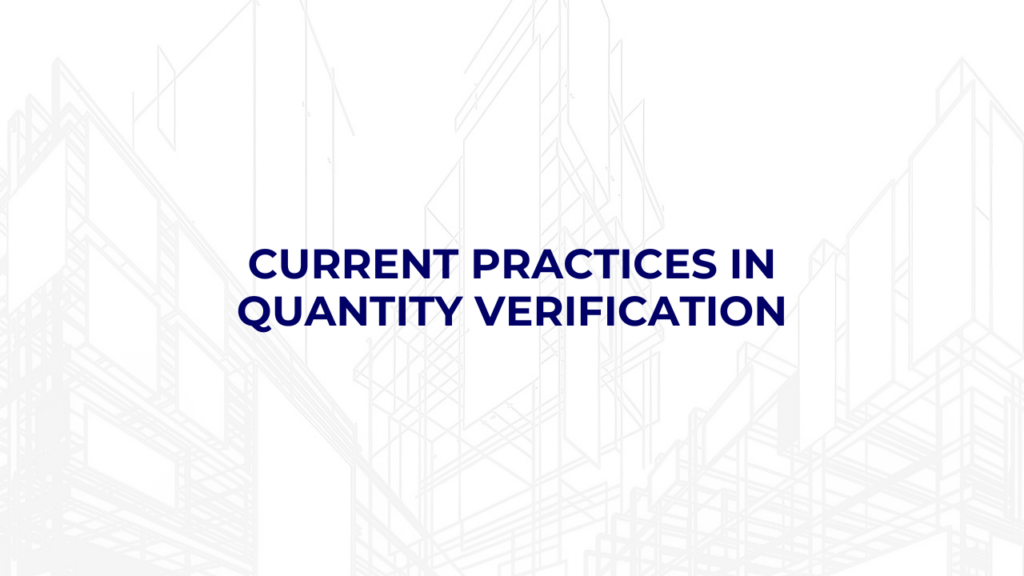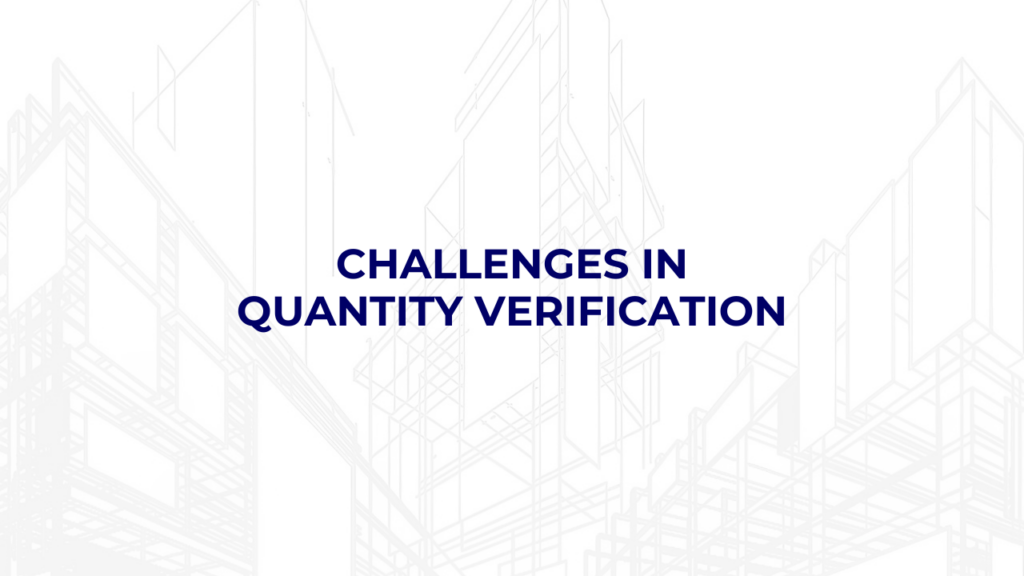Introduction to Quantity Verification
In the civil construction industry, quantity verification ensures that the recorded quantities of materials, labor, and resources align with those actually used in the project. It’s vital for controlling costs, validating bills, and ensuring materials are utilized efficiently. By accurately tracking quantities, project teams can manage resources, prevent discrepancies, and avoid cost overruns, helping maintain project integrity.
Practices, Challenges, and How EZYPRO Simplifies the Process
Current Practices in Quantity Verification

Quantity verification is a fundamental process in civil construction, ensuring that the materials and resources used align with the specified and recorded quantities. The primary objective is to validate that resources are used efficiently and align with budget constraints. Several traditional practices are commonly employed to achieve this, although they often have limitations:
- Manual Inspections and Measurements:
One of the most widely used practices, manual inspection involves on-site personnel measuring materials such as concrete volumes, steel lengths, and other essential construction components. Teams manually assess whether these materials conform to project specifications. While this approach offers hands-on validation, it requires experienced field staff and considerable time investment. Additionally, manual measurements are susceptible to human error, especially when performed under pressure or time constraints. - Reference to the Bill of Quantities (BOQ):
The BOQ serves as the project’s financial and resource blueprint, outlining all approved quantities and estimated costs. Project managers and field staff often cross-reference quantities against the BOQ to verify compliance with specifications. However, referencing the BOQ is typically a manual process, requiring personnel to reconcile actual usage with BOQ data. This approach can become cumbersome when data is spread across multiple formats or documents, making real-time tracking difficult. - Site Surveys and Cross-Checking:
Regular site surveys are another key practice in quantity verification, where project managers conduct on-site inspections and cross-check documentation. This method ensures that delivered materials, stored items, and in-use resources align with planned quantities. Surveys often involve documenting material quantities at various stages and comparing them to records from previous stages. Though valuable for capturing discrepancies, site surveys can be resource-intensive and may not capture issues that arise between scheduled survey periods. - Use of Spreadsheets and Basic Digital Tools:
Many construction teams have turned to spreadsheets and basic digital tools to organize and summarize quantity data. These tools assist in calculating quantities and generating reports, providing a more systematic alternative to fully manual approaches. However, these spreadsheets are usually not integrated with the BOQ, resulting in fragmented data and complicating the reconciliation process. Additionally, spreadsheets lack advanced tracking features and data security protocols, making them less reliable for large, complex projects. - Third-Party Audits:
Some construction firms also engage third-party auditors to verify quantities, ensuring an unbiased review of material usage and records. Audits can offer an objective assessment and may identify discrepancies overlooked by internal teams. However, these audits are generally periodic rather than continuous, and the findings might not reflect the most current project status, limiting their effectiveness for real-time project control.
Each of these practices serves an essential purpose in the quantity verification process. Yet, the reliance on manual processes, limited automation, and lack of real-time integration can create bottlenecks, slow down decision-making, and increase the potential for errors.
Challenges in Quantity Verification

Despite the diligent use of traditional practices, quantity verification in construction faces several persistent challenges that can hinder project efficiency and lead to increased costs. Understanding these challenges helps in designing better systems and adopting advanced solutions like EZYPRO:
- Human Error in Manual Processes:
Quantity verification involves numerous manual steps, from measuring quantities on-site to entering data into spreadsheets or databases. Each step introduces the potential for error. In construction, even minor miscalculations or misreported quantities can have a significant impact on project costs, material usage, and overall project timelines. Human error can stem from fatigue, oversight, or time pressure, especially on complex projects with tight schedules. - Time-Intensive and Labor-Heavy Processes:
Manual quantity verification is often time-consuming, with field staff required to measure, document, and compare quantities at various project stages. In addition to slowing down the project, this approach can create delays in billing, approvals, and material ordering, impacting project flow and budget. Projects relying on manual verification may experience bottlenecks, with quantity checks delaying downstream activities. - Data Silos and Fragmented Information:
Quantity data is typically collected by multiple teams working on different aspects of the project, such as procurement, inventory, and site management. When these teams use non-integrated tools like spreadsheets or separate databases, it creates isolated “data silos.” Reconciling these silos is complex, and important information may be overlooked or misaligned across phases, making it difficult to get a comprehensive view of material usage. Data fragmentation leads to inefficiencies, making it challenging to consolidate information and preventing seamless project oversight. - Risk of Overbilling and Fraud:
Without a robust quantity verification system, construction projects face the risk of overbilling, unauthorized approvals, and fraudulent reporting of quantities. In environments where manual checks are the norm, it is easier for discrepancies to go unnoticed. For example, inflated invoices may go undetected due to inaccurate quantity records, or unauthorized material usage may escape scrutiny. These risks compromise the project’s financial integrity, potentially increasing costs and damaging client trust. - Lack of Real-Time BOQ Integration:
In many cases, quantity verification systems do not have direct integration with the BOQ, creating a disconnect between planned and actual quantities. Without real-time comparison, project managers lack timely visibility into discrepancies between approved BOQ amounts and on-site usage. This lack of integration limits the ability to proactively address issues, leaving the team to catch discrepancies only after they have impacted the project. - Inconsistent Approval Workflows:
Construction projects often require multi-level approval workflows, particularly for high-value materials or critical stages. Traditional systems may not support consistent approval tracking, leading to delays and inefficiencies. Without automated workflows, approvals are often paper-based or reliant on emails, which can be misplaced or delayed. Inconsistent workflows also reduce accountability, making it challenging to identify the origin of discrepancies in quantity data. - Difficulty in Forecasting and Adjusting for Future Needs:
Manual quantity verification methods limit the ability to make accurate forecasts based on current usage data. For example, if a project is consuming more materials than anticipated, traditional methods may not immediately flag this deviation, leading to inaccurate projections and potential material shortages. Forecasting challenges can delay procurement, impacting schedules, and driving up costs due to last-minute orders.
These challenges underscore the need for an integrated, automated approach to quantity verification that not only mitigates errors and delays but also aligns closely with the BOQ, supports real-time tracking, and fosters transparent workflows.
How EZYPRO Verifies Quantities Against the BOQ and Solves Challenges
EZYPRO provides a streamlined, efficient approach to quantity verification by directly integrating BOQ data with field verification processes, ensuring that all quantities are automatically checked and validated against approved values. Here’s how EZYPRO enhances quantity verification:
- Automatic Quantity Verification with BOQ Integration: EZYPRO allows users to upload the BOQ directly into the system, setting it as a benchmark for approved quantities. As the contractor’s work is completed on-site, the system automatically deducts it from the BOQ-approved quantities, keeping an up-to-date record of the remaining quantities.
- Real-Time Quantity Adjustments: EZYPRO tracks actual usage against the BOQ and reflects real-time quantity adjustments, providing immediate feedback on work done and highlighting any deviations from planned quantities.
- Automated Bill Generation Aligned with Verified Quantities: EZYPRO automatically generates billing reports based on the verified quantities, referencing only those aligned with BOQ-approved amounts. The system continuously compares actual quantities against the BOQ, ensuring that invoices reflect only verified quantities without discrepancies. This process eliminates the risk of overbilling, prevents unauthorized entries, and generates detailed reports on usage patterns, highlighting any variances from BOQ-approved amounts. This automated billing feature reduces manual calculations, expedites approvals, and enhances invoicing accuracy, leading to better cost control and streamlined project finances.
- Data Transparency and Accountability: Each quantity verification entry is logged with a digital trail, making it easy to trace quantity usage and providing accountability for every entry. Project managers can access historical data to review quantity trends and identify any issues early.
- Efficient Approval Workflows: EZYPRO provides an easy-to-navigate interface for approvals, where supervisors can review automatically generated quantities and approve them digitally. This speeds up the approval process and reduces bottlenecks.
- Reduced Manual Effort and Error: By automating verification through the BOQ, EZYPRO minimizes manual calculations and entries, significantly lowering the risk of errors and increasing efficiency.
Conclusion
Effective quantity verification is essential for cost control, transparency and accurate billing in construction projects. Traditional manual processes often face issues such as delays, errors, and lack of BOQ integration. EZYPRO addresses these challenges by automating quantity verification with reference to the BOQ, cutting and tracking quantities in real time, and generating bills accordingly. This integration ensures efficient project management, reduces risk, and enhances data accuracy, ultimately helping construction teams achieve successful project outcomes.









1 Comment